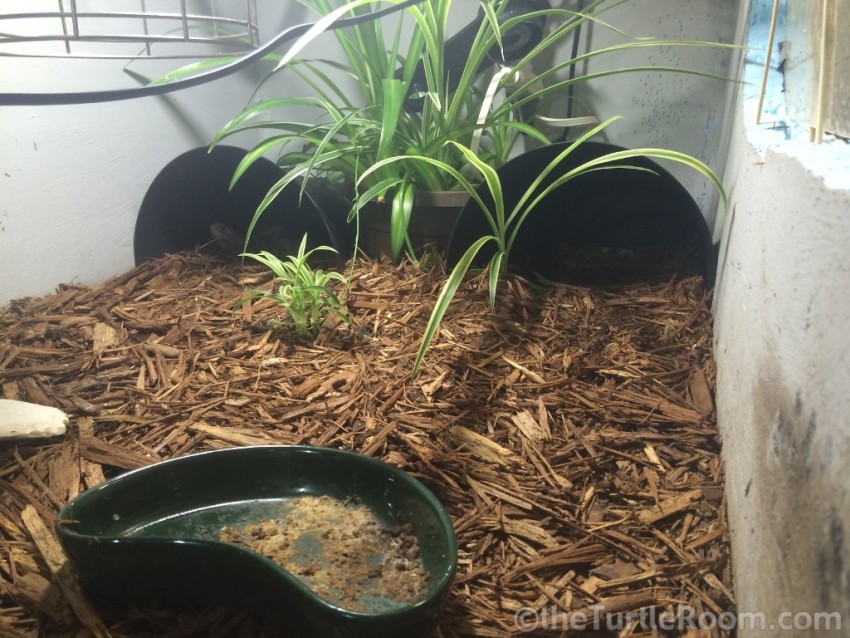Joe details the acclimation and care of Cuora mouhotii obsti (Southern Keeled Box Turtles).
 I believe that creating and maintaining a proper enclosure, as cloase as possible to the natural environment of the species, greatly increases the chance for a successful acclimation and healthy, happy turtles. To pursue this goal, I split my group into three enclosures; one for each of the two males and a single enclosure for the two females to share. I keep the males alone due to potential aggression concerns. Cuora mouhotii obsti needs adequate space; they have an unusually high gait and tend to trample over anything in their path. In addition, this species has an incredible talent for climbing, so that must be kept in mind. With all of this said, a reasonably large, escape-proof enclosure is necessary.
I believe that creating and maintaining a proper enclosure, as cloase as possible to the natural environment of the species, greatly increases the chance for a successful acclimation and healthy, happy turtles. To pursue this goal, I split my group into three enclosures; one for each of the two males and a single enclosure for the two females to share. I keep the males alone due to potential aggression concerns. Cuora mouhotii obsti needs adequate space; they have an unusually high gait and tend to trample over anything in their path. In addition, this species has an incredible talent for climbing, so that must be kept in mind. With all of this said, a reasonably large, escape-proof enclosure is necessary.
Their enclosures are relatively simplistic, but functional to meet their needs in my current setting. The room in which they live averages a relative humidity of between 50%-70% year-round, so my enclosures lack a lid to trap humidity in. In addition to the humidity requirement, this species is very shy and is not fond of bright light. As far as temperature goes, the enclosure averages approximately 70°F. This seems to work well. 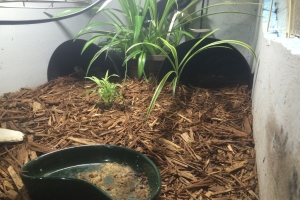 Southern Keeled Box Turtles do not need a basking lamp, but creating a temperature gradient throughout the enclosure is beneficial for them to self-regulate their body temperature.
Southern Keeled Box Turtles do not need a basking lamp, but creating a temperature gradient throughout the enclosure is beneficial for them to self-regulate their body temperature.
Each male has an enclosure measuring 48″ long by 28″ wide including a large soaking dish and a hide. The two females live together in an enclosure twice the area of each male’s; it is 96″ long by 28″ wide. They have ample space to choose to be alone or together and do as they please. Their enclosure is fitted with a large filtered soaking area, multiple hides, and a large pothos plant to create additional canopy. Each of the three enclosures are lighted, but is not overly bright and has plenty of shadows, since they are not fond of bright light.
Cuora mouhotii obsti is a terrestrial species, but also seem to be quite fond of sitting in their soaking pools for extended periods of time. Three of the four in my group have been observed spending entire days in their pools, while the last spends most time burrowed into dark corners with high humidity. I believe this is based solely on the individual animal’s preference, but also believe that deep soaking dishes should always be provided to leave the choice up to the turtle. 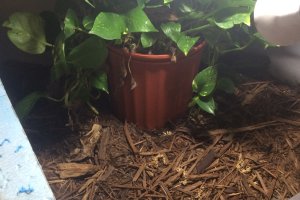 Given a deep enough substrate, my Southern Keeled Box Turtles have been observed burrowing out of sight, only to come out for food. While allowing them to fully burrow can aid in their acclimation, I find that providing substrate only deep enough to not-quite-bury-themselves brings out the best of their “majestic” personalities. While this group of Cuora mouhotii obsti has only been in my possession for about 9 months now, all four turtles will come charging out of their soaking dish, hidey-hole, or burrow for food when I walk by. Some of them will even follow me0 around their enclosure when I perform the daily regimen. Once acclimated to captivity, their personalities really shine.
Given a deep enough substrate, my Southern Keeled Box Turtles have been observed burrowing out of sight, only to come out for food. While allowing them to fully burrow can aid in their acclimation, I find that providing substrate only deep enough to not-quite-bury-themselves brings out the best of their “majestic” personalities. While this group of Cuora mouhotii obsti has only been in my possession for about 9 months now, all four turtles will come charging out of their soaking dish, hidey-hole, or burrow for food when I walk by. Some of them will even follow me0 around their enclosure when I perform the daily regimen. Once acclimated to captivity, their personalities really shine.
During the spring and summer, I keep the enclosures wet, but not soggy. To help keep the humidity at the proper, high level, I hose the enclosure down weekly.  In their natural range, the spring and summer are part of the monsoon season. As such, keeping the habitat wet and humid is natural for them. During the fall, I will slowly increase the time between each soaking of the enclosure to help gradually shift them into the brumation season in the winter. Winter temperatures in their native habitat drop as far as the low 50s, so I will try to imitate this as best as I can. Keeping this natural season change will help them acclimate to their new home. Last winter, I prevented brumation to prevent any of their health concerns from getting worse.
In their natural range, the spring and summer are part of the monsoon season. As such, keeping the habitat wet and humid is natural for them. During the fall, I will slowly increase the time between each soaking of the enclosure to help gradually shift them into the brumation season in the winter. Winter temperatures in their native habitat drop as far as the low 50s, so I will try to imitate this as best as I can. Keeping this natural season change will help them acclimate to their new home. Last winter, I prevented brumation to prevent any of their health concerns from getting worse.
Similarly to other Asian terrestrial turtles, Southern Keeled Box Turtles do not go out of their way for much, and lead a very sedentary (but personable) life. I feed my group twice a week. During the 5-month quarantine period I previously wrote about, we stuck with chopped fruit and live feeders (with calcium supplements) to comprise the majority of the diet. Once the quarantine period ended, we slowly started to introduce commercial pellets, replacing a portion of the live food choices. The pellets we chose were a blend of Koi pellets and Mazuri Freshwater Turtle Diet. The pellets would be soaked in warm water for 60-90 seconds and then mixed in with the fruit. 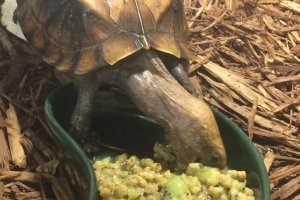 Before the introduction to the pellets, we saw very slow weight gain and no visible growth. Since introducing the nutritionally complete pellets, we have seen visible growth, solid weight gain, and now weight maintenance as they display on minor variance in weight from each monthly weigh-in to the next.
Before the introduction to the pellets, we saw very slow weight gain and no visible growth. Since introducing the nutritionally complete pellets, we have seen visible growth, solid weight gain, and now weight maintenance as they display on minor variance in weight from each monthly weigh-in to the next.
The current diet I feed my group is a 50/50 mixture of over-ripe fruits (including banana, kiwi, raspberries, strawberries, and blueberries) and Mazuri Freshwater Turtle Diet that has been soaked, as mentioned previously. Twice a month, I add a calcium/Vitamin D powder and once a month, I add a multivitamin powder. Fast growth should not be expected or attempted with Cuora mouhotii obsti. They are known for slow, but stead growth; overfeeding can quickly lead to obesity and other health complications.
I have attempted to encourage breeding a few times with no successes to date. I believe this was to the lack of a cooling period during their acclimation last winter. The brumation period appears to be a very important process to instigate breeding desire, particularly with the females. Males, on the other hand, are very aggressive during their time with the females and should be monitored to prevent and injuries to the females. 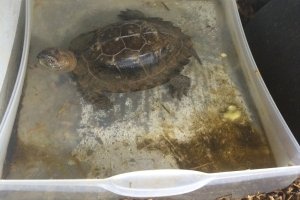 During breeding attempts, males will mount the female and attempt to bite the female’s face and neck. They will also bite the front marginal scutes, and in some females the scutes have been damaged from large, overly-aggressive males. This is one of the main reasons I keep my males separate from the females, only to be introduced for breeding. In one breeding attempt, I introduced both males to the females simultaneously. They fought to establish dominance which, while seemingly being a brutal fight, helped peak the interest of one female who was receptive to the victor of the battle. Once the winner was clearly determined, the loser was removed from the “battle arena” to prevent any harm.
During breeding attempts, males will mount the female and attempt to bite the female’s face and neck. They will also bite the front marginal scutes, and in some females the scutes have been damaged from large, overly-aggressive males. This is one of the main reasons I keep my males separate from the females, only to be introduced for breeding. In one breeding attempt, I introduced both males to the females simultaneously. They fought to establish dominance which, while seemingly being a brutal fight, helped peak the interest of one female who was receptive to the victor of the battle. Once the winner was clearly determined, the loser was removed from the “battle arena” to prevent any harm.
Given the proper enclosure, temperature, and humidity levels Cuora mouhotii obsti should acclimate to captivity over time. I found that bothering too much with handling increases stress levels and leads to frequent hiding and ignoring food. Too much interaction without purpose should be avoided to keep stress low. An enclosure with opaque walls would be best, especially if kept in high-traffic areas. The captive care of this species is relatively simple, once you establish a routine. After a successful acclimation, they are low-maintenance with great personalities. The care regimen outlined above has been very successful for me, and the 4 Keeled Box Turtles in my care have become very hardy animals since their acclimation period.


